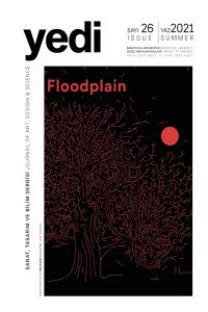Seramiğin Bir Kap Olarak Ölü Gömme Geleneklerinde Rolü
İnsanlığın yerleşik yaşama geçmesinden sonra ortaya çıkan ihtiyaçlarını karşılamak üzere seramik çamurunu şekillendirip pişirerek kendisine seramik kap yapması, belki de en önemli buluşlarından biri olmuştur. Seramik kapların üretilmeye başlanmasından günümüze kadar geçen tarihsel süreçte seramik, değişen işlevi ve biçimiyle hep insanın yanında olmuş, ona eşlik etmiştir. Bu uzun tarihsel süreçte kendi içinde sürekli bir değişim ve gelişim göstererek zengin bir gelenek, zengin bir bilgi birikimi yaratmıştır. Doğada çok bulunması ve şekillendirilmesi kolay bir malzeme olmasının avantajıyla, onu şekillendiren seramikçilerin ellerinde sayısız biçimde ve çeşitlilikte eşsiz güzellikteki seramiklere dönüşmüştür.Seramik kaplar, yiyecek ve içecekleri, değerli sıvıları, mücevherleri, ilahi güçlere verilen sunuları ve daha birçok şeyi; sahip olduğu iç boşluğunda saklayıp korumanın, bir yerden bir yere taşımanın yanında, bu dünyadaki yaşamı sona eren insanı, içinde saklayıp koruyarak, insanın bilinmeze olan yolculuğunda ona eşlik eder. Ölenin ardından tutulan yas, düzenlenen törenler ve ölünün gömülme biçimi her toplumda farklılık gösterse de seramik gömme gelenekleri içinde farklı roller üstlenmiş ve insanla yaşamı boyunca sürdürdüğü ilişki ölümünden sonra da devam etmiştir.Bu araştırmada, antropolog ve arkeologların ölü gömme gelenekleri üzerine yaptıkları araştırmalar ve saptamalar ışığında, seçilen tipik seramik kapların ölü gömme geleneklerinde oynadıkları roller incelenecek ve seramiğin ölüm sonrası insanla kurduğu ilişki ortaya koyulmaya çalışılacaktır.
The Role of Ceramics in Dead Burial Traditions as a Container
It has been perhaps one of humanity’s most important inventions to make ceramic containers by shaping and firing clay to meet the needs that emerged after its settled down. In the historical period since the production of ceramic containers, ceramics have always been with a man and accompanied him with his changing function and form. This long historical process has created a rich tradition and knowledge by constantly changing and developing within itself. With the advantage of being a very present and easy-to-shape material in nature, ceramics has become uniquely beautiful in numerous shapes and varieties in the hands of the ceramicists who shaped it.Ceramic containers are aimed to contain food and beverages, precious liquids, jewelry, presentations to divine powers and many other things, in addition to hiding, protecting, moving a place from one place to another, keep and protect the person whose life on this earth ends in it, accompany him on his journey into the unknown. Although the mourning, ceremonies, burial of the deceased differed in each society, ceramic burial traditions played different roles and the relationship with man throughout his life continued after his death.In this research, in the light of the researches and determinations made by anthropologists and archaeologists on the traditions of burial, the roles played by the typical selected ceramic containers in the dead burial traditions will be examined and the relationship of ceramic vessels with the postmortem human will be tried to be revealed.
Keywords:
Ceramic, dead burial, tradition,
___
- Aldırmaz, C., Okumuş, H. ve Cengiz, Ş. (2009). Doğum adetlerinde kullanılan Çanakkale testi ve sürahilerin sembolik dili. Zeynep Kâmil Tıp Bülteni, 40(1), 46.
- Alper, O. ve Kolağasıoğlu, M. (2018). Amisos’ta urne mezar geleneği. Amisos Dergi, 3(4), 167-200.
- Becker, J. A. (t.y.). Sarcophagus of the Spouses (Rome). Khan Academy. https://www.khanacademy.org/humanities/ap-art-history/ancient-mediterranean-ap/ap-ancient-etruria/a/sarcophagus-of-the-spouses-rome
- Canopic jar. (2021, Kasım 26). In Wikipedia . https://en.wikipedia.org/wiki/Canopic_jar
- Cengiz, C. (2019). Doğudan batıya kültür nesnesi olarak porselen (Tez No. 600430) [Yüksek lisans tezi, Dokuz Eylül Üniversitesi]. Ulusal Tez Merkezi.
- Çoruhlu, Y. (2019). Orta Asya’da ölü kemiği muhafaza kapları (Ossuary / Navs) ve Türk Sanatı’ndaki yeri üzerine değerlendirmeler. Akdeniz Sanat Dergisi [Özel sayı], 13( 23), 873-896.
- Death io. (t.y). A brief history of the urn. https://www.death.io/brief-history-urn/
- Detroit Institute of Arts. (t.y.). Mogollon Mimbren, Bowl. https://www.dia.org/art/collection/object/bowl-54783
- Dipylon Krater. (t.y.). In Wikiwand. https://www.wikiwand.com/en/Dipylon_krater#/Description_of_the_Dipylon_krater_in_New_York
- Firik, H. (2018, 23 Eylül). Antandros Antik Kentinde pitos mezarlar bulundu. Arkeolojik Haber. https://www.arkeolojikhaber.com/haber-antandros-antik-kentinde-pitos-mezarlar-bulundu-16973/
- Harke, H. (2014, 9 Haziran). Grave goods in early medieval burials: Messages and meanings. Mortality, 41-60. doi: 10.1080/13576275.2013.870544
- Hudson, M. ve Barnes, G. L. (1991). Yoshinogari. A Yayoi Settlement in Northern Kyushu. Monumenta. Nipponica. 46. 211-235. https://www.jstor.org/stable/2385402?seq=15#metadata_info_tab_contents
- Huntsman, T. ve Becker, M. J. (2013). An analysis of the cremated human remains in a terracotta cinerary urn of the third-second century BCE from Chiusi now in the Metropolitan Museum of Art in New York. De Gruyter, 153–164. doi: 10.1515/etst-2013-0011.
- Jude, I. (2013, Mayıs). On the trail of the Mimbres. Archeolagy. A publication of the Archaeological Institute of America. https://www.archaeology.org/issues/89-1305/features/738-mimbres-bowls-southwest-collapse-reorganization
- Kırkıl, D. (2019). Anadolu kalkolatik dönemi’nde ölü gömme uygulamaları (Tez No. 596465) [Yüksek lisans tezi, Sivas Cumhuriyet Üniversitesi]. Ulusal Tez Merkezi.
- Kucur, D. (2013). Anadolu’da dairesel kesitli pişmiş toprak lahitler. (Tez No. 340543) [Doktora tezi, İstanbul Üniversitesi]. Ulusal Tez Merkezi. Metmuseum. (t.y.). Canaopic jar of Ruiu. https://www.metmuseum.org/art/ collection/search/549138
- Minoan larnax. (t.y.). In Wikimedia commons. https://commons.wikimedia.org/wiki/File:Minoan_larnax,_brids,_carriage,_seascape,_Crete,_AMH,_145315.jpg
- Scott, N. (2015, 19 Kasım). Grave markers of the ancient elite. Furman University scholer excange. https://scholarexchange.furman.edu/art231/1/
- Tarih ve Arkeoloji. (2014, 15 Temmuz). Klazomenai/Urla lahitleri. https://tarihvearkeoloji.blogspot.com/2014/07/klazomenai-urla-lahitleri.html
- Watrous, L. V. (1991). The origin and iconography of the late Minoan Painted Larnax. The American School of classical studies at Athens, 60(3), 285-307. doi: 10.2307/148065
- Yağız, K. (2014). Antandros mezar taşları. TÜBA-AR Dergi, 17, 129-142.
- ISSN: 1307-9840
- Başlangıç: 2007
- Yayıncı: Dokuz Eylül Üniversitesi
Sayıdaki Diğer Makaleler
Seramiğin Bir Kap Olarak Ölü Gömme Geleneklerinde Rolü
Kadın Giyim Modasında Siyah Renk Kullanımı
Sevda DEMİR PARLAK, Nesrin ÖNLÜ
Beyaz Tekstil ve Giyim Ürünlerinde Anlam
Dijital Karşılaşmalar: Taktiksel Sanat Müdahalelerinin Politikası
JOSEPH BEUYS’UN SANATINDA YAĞ ve KEÇE
Resim Kompozisyonları ve Üsluplarının Sahne Tasarımında Kullanım Yöntemleri
